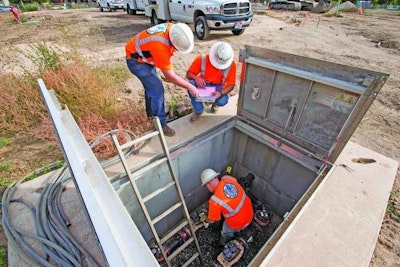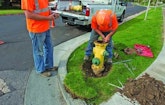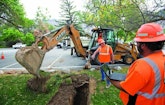
Interested in Inspection?
Get Inspection articles, news and videos right in your inbox! Sign up now.
Inspection + Get AlertsOgden, Utah, is a city of about 83,000 with a plan for infrastructure renewal. Its Public Utilities Department has tackled everything from an aggressive program to address leaks to the challenging replacement of a 100-year-old transmission main running through a narrow canyon.
Ogden is an economic hub located about 40 miles north of Salt Lake City, nestled between the Great Salt Lake to the west and the Wasatch Mountain Range to the east. The Public Utilities Department dates back to 1846. While it once held responsibility for sewer services, it now handles sewer billing only, with rates based on water usage. Sewer maintenance is the responsibility of the Ogden City Public Ways and Parks Department Sewer Division, while sewer construction is the responsibility of the city’s Engineering Division. The Central Weber Sewer District is responsible for the city’s wastewater treatment.
The city derives much of its water from a series of underground wells. It also relies on Pineview Reservoir, an engineered lake to the east, which supplies the city via gravity-fed transmission mains that run through rugged Ogden Canyon. A water treatment plant at Pineview supplements the city’s water supply during peak demand.
“The wells are more reliable and less susceptible to drought,” says Kenton Moffett, P.E., Public Utilities manager with the City of Ogden. “We generally rely on the reservoir during summer months when we need to increase water supply to meet irrigation demands.”
Steel pipe a problem
Water pipe infrastructure ranges in size from 2 inches in diameter to 36 inches for transmission mains. Some of the water infrastructure dates back to the 1930s — and some of the original choices of pipe material have not served the city well.
“The smaller-diameter pipe is approximately 60 percent steel and 40 percent cast iron,” Moffett says. “We have a lot of different soil types in Ogden and they’re inconsistently distributed. It ranges from alluvial deposits to hot soils that really take their toll on the pipe. The steel pipe in particular rusts inside and out and is responsible for a large number of the leaks we see in the system.”
The utility is responding with two five-person crews devoted entirely to tracking down and repairing system main and service leaks, having tackled more than 400 leaks in the past year.
“We literally find ourselves fixing so many leaks that there’s no need for a leak detection program at this stage,” Moffett says. “We use Pollard Geophones (Pollardwater) to narrow down the location of leaks, and we’ve toyed with the idea of acquiring some correlators, but we’re not waiting around looking for leaks. Typically we get homeowners reporting service leaks or we see the water main leaks as the water reaches the surface. We’re experiencing more leaks on service lines than on the mains.”
Getting a lead on leaks
As part of the fight, the utility is planning to replace frequency transmitter water meters that require a transceiver-equipped truck with fully automated meters.
“That decision is being made in part to free up crew time so that we can get ahead of leaks,” says Moffett.
The crews will clamp main breaks and replace short runs of leaking pipe, but will generally contract out larger construction jobs.
The water system is currently being GIS mapped using ArcGIS by Esri, a process nearing completion.
“We’ve been moving ahead by leaps and bounds over the past few years with most of our mains mapped and our 24,000 service lines in progress,” Moffett says.
“We have one person in charge of the GIS mapping program, and service crews are now importing their own data directly into the GIS map from the field, including photos they snap of the infrastructure.”
Boosting the backbone
The utility uses GIS data combined with leak reports to prioritize water main replacement, emphasizing large-diameter pipelines — the “backbone” of the system.
The replacement material of choice is largely PVC because of its stability in a wide variety of soils.
“Our water main replacement program accelerated in 2008 following a large break in our Ogden Canyon transmission main that cut out water to 4,000 people in the northern part of the city,” Moffett says. “You don’t realize what you’ve got until it’s gone. Funding increases for water main replacement followed soon after that, and we established a goal of replacing 2.5 percent of the system every year — after we dealt with Ogden Canyon.”
Construction of the original Ogden Canyon pipeline was completed in 1919 using 24-inch steel pipe and human labor (see sidebar). “After almost 90 years of service, our inspection revealed that it was leaking like a sieve,” Moffett says. “We knew we had to replace significant portions of the pipe.”
Ogden Canyon is a constricted box canyon with a narrow bottom. While the crews who originally built the pipeline faced many challenges, modern construction crews faced an additional problem — much of the pipe was now buried directly underneath busy Utah State Highway 39, a two-lane route running along the canyon bottom. The Ogden River, which also runs through the canyon, would provide additional challenges for construction material staging and equipment access.
Because of summer water demands, construction would have to be scheduled for winter. A single 36-inch transmission main would be responsible for supplying the city’s needs until summer.
Pipe bursting ruled out
“We originally considered pipe bursting, but they backfilled the pipeline with rocks the size of Volkswagens and that made pipe bursting unworkable,” Moffett says. In addition, vertical rock faces extending into trenches and a shallow bury depth of about 2 feet made pipe bursting impractical.
The city ultimately opted for open-cut using Fusible C-905 DR15 PVC pipe for the higher-pressure section in the lower canyon, and harnessed bell-and-spigot C-905 DR18 PVC pipe for higher elevations. The pipe, supplied by Underground Solutions of Denver, would be buried to a depth of 4 feet.
Whitaker Construction of Brigham City, Utah, was the general contractor on the $9 million project, while Horrocks Engineering of Pleasant Grove, Utah, was the design consultant.
Construction began in fall 2012 on the downstream section of the pipe, working up the canyon. Workers used existing trenches where possible, but that meant they had to remove the old steel pipe as well. Wherever possible, open cuts avoided the road surface, running parallel to the highway.
“Between materials, trucks, workers, snow clearing and temporary paving, we were in tight quarters,” Moffett says. “In quite a few places we’d have to go in with a rock hammer. We typically had to shut down one lane during the day and completely close the very busy road at night. This had some of the drivers up in arms.
That is, until we put sections of the damaged steel pipe on display alongside the road so they could see what we were replacing. That stopped a lot of the complaints.”
Work continued all winter through fierce canyon winds and extreme cold. Construction schedules were accelerated to include nighttime work.
Record cold grips Ogden
“It wasn’t a fun time for construction workers,” Moffett says. “We hit record low temperatures that February, and at times equipment would get frozen to the ground.”
A separate and additional project involved running another main up the steep canyon wall to supply water to the city’s storage lagoons. Sunrise Engineering of Draper, Utah, designed this portion of the project and Whitaker Construction completed the installation.
The project was completed on schedule in summer 2013 and received the Utah Associated General Contractor’s 2013 Utility Project of the Year award for its innovative use of construction techniques and problem-solving.
The Ogden Canyon pipeline has been in service for three years and is performing flawlessly.
“We’re proud to have pulled it off successfully with so many challenges,” Moffett says. “Our next goal is to work so far ahead on leak repairs that we move from being reactive to proactive. In all, we believe that the backbone of our water system is now much more reliable.”









